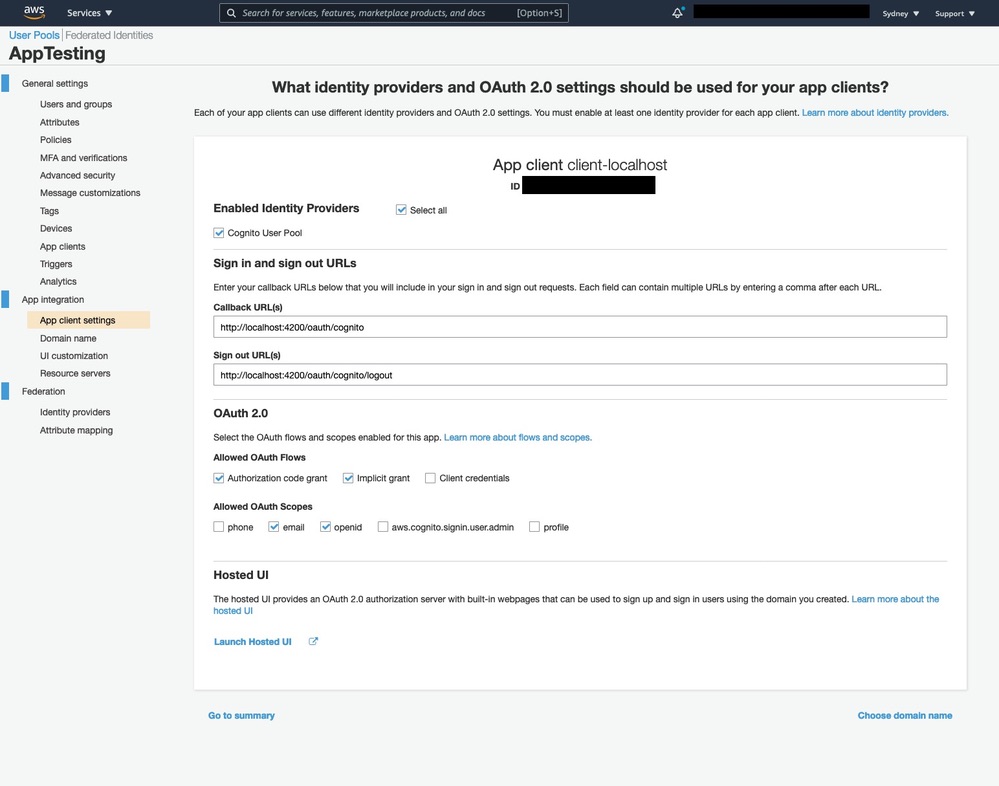Amazon Cognito Hosted UI provides you an OAuth 2.0 compliant authorization server. In this repository you can find a working example using Amazon Cognito User Pools Auth API Reference.
We take advantage of Amazon Cognito OAuth Domain Name to exchange tokens and access user information in our Amazon Cognito User Pool.
Note: If you want to update the user attributes in the user pool, you still need to build / provite a CRUD API using AWS-SDK. This is out of the scope of this article.
The example above assumes a few things:
- There's NO MFA CONFIGURED in the Cognito User Pool
- There's EMAIL VERIFICATION by the Cognito User Pool (e.g. you need a valid email in the sign up process)
- Password policy is "Minimum length: 6" only (e.g. numbers, special character verification are turned off)
- Pool Id - REDACTED (Unique to you)
- Poolr ARN - REDACTED (Unique to you)
- Required attributes - none
- Alias attributes - none
- Username attributes - email
- Enable case insensitivity? - Yes
- Custom Attributes - none
- Minimum password length - 6
- Password policy - no requirements
- User sign ups allowed? - Users can sign themselves up
- FROM email address - Default
- Email Delivery through Amazon SES - No
- MFA - Disabled
- Verifications - Email
- Advanced security - none
- Tags - none
- App clients - client-localhost
- Triggers - none
We configured ONE app client to work with localhost urls.
You can create multiple app clients to work with different environments (e.g. web-client, mobile-client, qa-client etc).
Configuration used when creating the app client:
- App client name - client-localhost
- Refresh token expiration - I kept default values (30 days and 0 minutes)
- Access token expiration - I kept default values (0 days and 60 minutes)
- ID token expiration - I kept default values (0 days and 60 minutes)
- IMPORTANT Generate client secret - Uncheck/Turn off this checkbox
- Auth Flows Configuration - I kept default values (values selected are:
ALLOW_CUSTOM_AUTH,ALLOW_USER_SRP_AUTH,ALLOW_REFRESH_TOKEN_AUTH) - Security configuration
-
Prevent User Existence Errors - I kept default values (checkbox for "Enabled (Recommended)" checked/turned on)
-
- Click "Create app client"
After the app client is created copy the unique App client id into .env on COGNITO_CLIENT_ID= variable.
Navigate to App integration > Domain name and check the availability of a Amazon Cognito domain. It will generate our OAuth 2.0 compliant authorization server.
You can also use your own domain for the authorization server, check the documentation for more instructions.
- Domain prefix - REDACTED (Unique to you)
Now we need to define OAuth flows and scopes for the App Client we created before (e.g. client-localhost). You can learn more about App Client Settings Terminology in the documentation.
- ID - REDACTED (Unique to you)
- Enabled Identity Providers - Check/turn on "Select all" checkbox
- Sign in and sign out URLs
-
Callback URL(s) - http://localhost:4200/oauth/cognito
-
Sign out URL(s) - http://localhost:4200/oauth/cognito/logout
-
- OAuth 2.0
-
Allowed OAuth Flows - Check/turn on "Authorization code grant" and "Implicit grant" checkboxes
-
Allowed OAuth Scopes - Check/turn on "email" and "openid" checkboxes
-
You are ready to run this example, make sure to:
- Copy
.env.exampleto.envand udpate ALL variables values - Run
npm install - Start the example with
npm start
If you have any questions you can reach out via twitter/oieduardorabelo.



